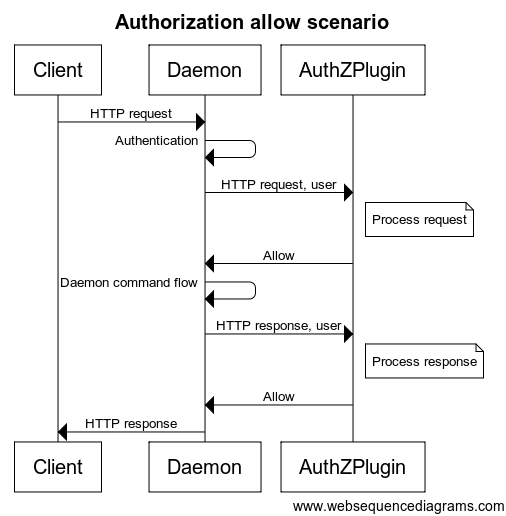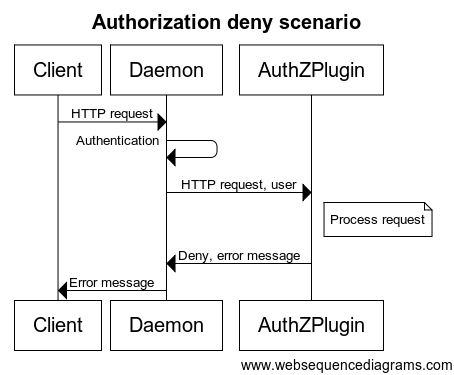github.com/kim0/docker@v0.6.2-0.20161130212042-4addda3f07e7/docs/extend/plugins_authorization.md (about) 1 --- 2 title: "Access authorization plugin" 3 description: "How to create authorization plugins to manage access control to your Docker daemon." 4 keywords: ["security, authorization, authentication, docker, documentation, plugin, extend"] 5 aliases: ["/engine/extend/authorization/"] 6 --- 7 8 <!-- This file is maintained within the docker/docker Github 9 repository at https://github.com/docker/docker/. Make all 10 pull requests against that repo. If you see this file in 11 another repository, consider it read-only there, as it will 12 periodically be overwritten by the definitive file. Pull 13 requests which include edits to this file in other repositories 14 will be rejected. 15 --> 16 17 # Create an authorization plugin 18 19 This document describes the Docker Engine plugins generally available in Docker 20 Engine. To view information on plugins managed by Docker Engine currently in 21 experimental status, refer to [Docker Engine plugin system](index.md). 22 23 Docker's out-of-the-box authorization model is all or nothing. Any user with 24 permission to access the Docker daemon can run any Docker client command. The 25 same is true for callers using Docker's remote API to contact the daemon. If you 26 require greater access control, you can create authorization plugins and add 27 them to your Docker daemon configuration. Using an authorization plugin, a 28 Docker administrator can configure granular access policies for managing access 29 to Docker daemon. 30 31 Anyone with the appropriate skills can develop an authorization plugin. These 32 skills, at their most basic, are knowledge of Docker, understanding of REST, and 33 sound programming knowledge. This document describes the architecture, state, 34 and methods information available to an authorization plugin developer. 35 36 ## Basic principles 37 38 Docker's [plugin infrastructure](plugin_api.md) enables 39 extending Docker by loading, removing and communicating with 40 third-party components using a generic API. The access authorization subsystem 41 was built using this mechanism. 42 43 Using this subsystem, you don't need to rebuild the Docker daemon to add an 44 authorization plugin. You can add a plugin to an installed Docker daemon. You do 45 need to restart the Docker daemon to add a new plugin. 46 47 An authorization plugin approves or denies requests to the Docker daemon based 48 on both the current authentication context and the command context. The 49 authentication context contains all user details and the authentication method. 50 The command context contains all the relevant request data. 51 52 Authorization plugins must follow the rules described in [Docker Plugin API](plugin_api.md). 53 Each plugin must reside within directories described under the 54 [Plugin discovery](plugin_api.md#plugin-discovery) section. 55 56 **Note**: the abbreviations `AuthZ` and `AuthN` mean authorization and authentication 57 respectively. 58 59 ## Default user authorization mechanism 60 61 If TLS is enabled in the [Docker daemon](https://docs.docker.com/engine/security/https/), the default user authorization flow extracts the user details from the certificate subject name. 62 That is, the `User` field is set to the client certificate subject common name, and the `AuthenticationMethod` field is set to `TLS`. 63 64 ## Basic architecture 65 66 You are responsible for registering your plugin as part of the Docker daemon 67 startup. You can install multiple plugins and chain them together. This chain 68 can be ordered. Each request to the daemon passes in order through the chain. 69 Only when all the plugins grant access to the resource, is the access granted. 70 71 When an HTTP request is made to the Docker daemon through the CLI or via the 72 remote API, the authentication subsystem passes the request to the installed 73 authentication plugin(s). The request contains the user (caller) and command 74 context. The plugin is responsible for deciding whether to allow or deny the 75 request. 76 77 The sequence diagrams below depict an allow and deny authorization flow: 78 79  80 81  82 83 Each request sent to the plugin includes the authenticated user, the HTTP 84 headers, and the request/response body. Only the user name and the 85 authentication method used are passed to the plugin. Most importantly, no user 86 credentials or tokens are passed. Finally, not all request/response bodies 87 are sent to the authorization plugin. Only those request/response bodies where 88 the `Content-Type` is either `text/*` or `application/json` are sent. 89 90 For commands that can potentially hijack the HTTP connection (`HTTP 91 Upgrade`), such as `exec`, the authorization plugin is only called for the 92 initial HTTP requests. Once the plugin approves the command, authorization is 93 not applied to the rest of the flow. Specifically, the streaming data is not 94 passed to the authorization plugins. For commands that return chunked HTTP 95 response, such as `logs` and `events`, only the HTTP request is sent to the 96 authorization plugins. 97 98 During request/response processing, some authorization flows might 99 need to do additional queries to the Docker daemon. To complete such flows, 100 plugins can call the daemon API similar to a regular user. To enable these 101 additional queries, the plugin must provide the means for an administrator to 102 configure proper authentication and security policies. 103 104 ## Docker client flows 105 106 To enable and configure the authorization plugin, the plugin developer must 107 support the Docker client interactions detailed in this section. 108 109 ### Setting up Docker daemon 110 111 Enable the authorization plugin with a dedicated command line flag in the 112 `--authorization-plugin=PLUGIN_ID` format. The flag supplies a `PLUGIN_ID` 113 value. This value can be the plugin’s socket or a path to a specification file. 114 Authorization plugins can be loaded without restarting the daemon. Refer 115 to the [`dockerd` documentation](../reference/commandline/dockerd.md#configuration-reloading) for more information. 116 117 ```bash 118 $ dockerd --authorization-plugin=plugin1 --authorization-plugin=plugin2,... 119 ``` 120 121 Docker's authorization subsystem supports multiple `--authorization-plugin` parameters. 122 123 ### Calling authorized command (allow) 124 125 ```bash 126 $ docker pull centos 127 ... 128 f1b10cd84249: Pull complete 129 ... 130 ``` 131 132 ### Calling unauthorized command (deny) 133 134 ```bash 135 $ docker pull centos 136 ... 137 docker: Error response from daemon: authorization denied by plugin PLUGIN_NAME: volumes are not allowed. 138 ``` 139 140 ### Error from plugins 141 142 ```bash 143 $ docker pull centos 144 ... 145 docker: Error response from daemon: plugin PLUGIN_NAME failed with error: AuthZPlugin.AuthZReq: Cannot connect to the Docker daemon. Is the docker daemon running on this host?. 146 ``` 147 148 ## API schema and implementation 149 150 In addition to Docker's standard plugin registration method, each plugin 151 should implement the following two methods: 152 153 * `/AuthZPlugin.AuthZReq` This authorize request method is called before the Docker daemon processes the client request. 154 155 * `/AuthZPlugin.AuthZRes` This authorize response method is called before the response is returned from Docker daemon to the client. 156 157 #### /AuthZPlugin.AuthZReq 158 159 **Request**: 160 161 ```json 162 { 163 "User": "The user identification", 164 "UserAuthNMethod": "The authentication method used", 165 "RequestMethod": "The HTTP method", 166 "RequestURI": "The HTTP request URI", 167 "RequestBody": "Byte array containing the raw HTTP request body", 168 "RequestHeader": "Byte array containing the raw HTTP request header as a map[string][]string " 169 } 170 ``` 171 172 **Response**: 173 174 ```json 175 { 176 "Allow": "Determined whether the user is allowed or not", 177 "Msg": "The authorization message", 178 "Err": "The error message if things go wrong" 179 } 180 ``` 181 #### /AuthZPlugin.AuthZRes 182 183 **Request**: 184 185 ```json 186 { 187 "User": "The user identification", 188 "UserAuthNMethod": "The authentication method used", 189 "RequestMethod": "The HTTP method", 190 "RequestURI": "The HTTP request URI", 191 "RequestBody": "Byte array containing the raw HTTP request body", 192 "RequestHeader": "Byte array containing the raw HTTP request header as a map[string][]string", 193 "ResponseBody": "Byte array containing the raw HTTP response body", 194 "ResponseHeader": "Byte array containing the raw HTTP response header as a map[string][]string", 195 "ResponseStatusCode":"Response status code" 196 } 197 ``` 198 199 **Response**: 200 201 ```json 202 { 203 "Allow": "Determined whether the user is allowed or not", 204 "Msg": "The authorization message", 205 "Err": "The error message if things go wrong" 206 } 207 ``` 208 209 ### Request authorization 210 211 Each plugin must support two request authorization messages formats, one from the daemon to the plugin and then from the plugin to the daemon. The tables below detail the content expected in each message. 212 213 #### Daemon -> Plugin 214 215 Name | Type | Description 216 -----------------------|-------------------|------------------------------------------------------- 217 User | string | The user identification 218 Authentication method | string | The authentication method used 219 Request method | enum | The HTTP method (GET/DELETE/POST) 220 Request URI | string | The HTTP request URI including API version (e.g., v.1.17/containers/json) 221 Request headers | map[string]string | Request headers as key value pairs (without the authorization header) 222 Request body | []byte | Raw request body 223 224 225 #### Plugin -> Daemon 226 227 Name | Type | Description 228 --------|--------|---------------------------------------------------------------------------------- 229 Allow | bool | Boolean value indicating whether the request is allowed or denied 230 Msg | string | Authorization message (will be returned to the client in case the access is denied) 231 Err | string | Error message (will be returned to the client in case the plugin encounter an error. The string value supplied may appear in logs, so should not include confidential information) 232 233 ### Response authorization 234 235 The plugin must support two authorization messages formats, one from the daemon to the plugin and then from the plugin to the daemon. The tables below detail the content expected in each message. 236 237 #### Daemon -> Plugin 238 239 240 Name | Type | Description 241 ----------------------- |------------------ |---------------------------------------------------- 242 User | string | The user identification 243 Authentication method | string | The authentication method used 244 Request method | string | The HTTP method (GET/DELETE/POST) 245 Request URI | string | The HTTP request URI including API version (e.g., v.1.17/containers/json) 246 Request headers | map[string]string | Request headers as key value pairs (without the authorization header) 247 Request body | []byte | Raw request body 248 Response status code | int | Status code from the docker daemon 249 Response headers | map[string]string | Response headers as key value pairs 250 Response body | []byte | Raw docker daemon response body 251 252 253 #### Plugin -> Daemon 254 255 Name | Type | Description 256 --------|--------|---------------------------------------------------------------------------------- 257 Allow | bool | Boolean value indicating whether the response is allowed or denied 258 Msg | string | Authorization message (will be returned to the client in case the access is denied) 259 Err | string | Error message (will be returned to the client in case the plugin encounter an error. The string value supplied may appear in logs, so should not include confidential information)